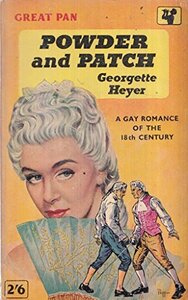You need to sign in or sign up before continuing.
Take a photo of a barcode or cover
adventurous
lighthearted
medium-paced
Plot or Character Driven:
A mix
Strong character development:
No
Loveable characters:
Complicated
Diverse cast of characters:
No
Flaws of characters a main focus:
Complicated
This was not my favorite Heyer. It was a bit too silly at times. And I have learned that I want to like the female protagonist in a Heyer novel - I want to root for her and see her happy - and I just wasn’t a fan of Cleone.
If this had been my first Heyer novel, I would never have read another one. I know Heyer was young and this was one of her earliest novels, but the writing is stilted, the dialogue is unbelievable, the characters are annoying, and the romance is not romantic.
My favorite part of this novel was a comedic moment when Cloreceives 3 proposals and finds herself engaged to 2 men in one evening.
There are 2 endings. I disliked the ending of Powder and Patch and hated the ending of The Transformation of Philip Jettan.
My favorite part of this novel was a comedic moment when Clo
There are 2 endings. I disliked the ending of Powder and Patch and hated the ending of The Transformation of Philip Jettan.
Light gothic romance fiction, among my Mom's favorites. Considerably better than the average gothic romance. Some of them are more like historical fiction, such as Simon the Coldheart. I read them from time to time when I was growing up.
A great deal fluffier than most of Heyer's writing, but none the less enjoyable for that. I certainly won't re-read it as often as I do many of her other books, which have heart and solid characters in a way which this doesn't, but I'll probably still re-read it occasionally, it does make an awfully good lunch break read!
I had read this earlier as Powder and Patch and it's a fine enough story. I don't like the heroine much, there's nothing to recommend her and the hero too acts from an agency of rebuke and revenge, so doesn't quite land as well as Heyer's other stories. Her knowledge and detailed descriptions of the customs and the dress of that era remains authoritative and firm as always.
(I am rereading the Georgette Heyer books I loved as a teen). This one did not hold up over time - a second reading just bored me. None of the characters ever really engaged me and I couldn't care less what happened to them.
Slow to start but tense to the finish. Classic bodice-ripping Heyer, a smouldering romance survives great changes in character and waves of unworthy suitors. Luckily for the reader, fate ensures the impossible. The predestined lovers marry, despite every trial and tribulation that Regency London and Paris can throw at them.
The moral of the story is to remember your roots, for men to be fashionable and assertive, and for women to relent to their destined fiancé when it’s obviously in their interest (as decided by their family, in cahoots with the fiancé-to-be).
The book is complete with a racial caricature as well as constant reference to gender roles. It is up to readers to decide whether this has any literary value as a commentary on the period.
Indeed, the character development of the chief protagonist centres on his transformation from an overly-direct country bumpkin into a sophisticate acting on the whims of societé. It is by combining his newfound wit with the will of his old ways that he succeeds in his endeavours. At each step, his sophistication and masculinity is measured by his sweetheart’s receptiveness to his advances. At first he is assertive, but too brutish. Then, he is fashionable but respects her autonomy too much. Finally, he figures out was apparently obvious all along, that he knows best for her but just needs to act on it poetically.
The moral of the story is to remember your roots, for men to be fashionable and assertive, and for women to relent to their destined fiancé when it’s obviously in their interest (as decided by their family, in cahoots with the fiancé-to-be).
The book is complete with a racial caricature as well as constant reference to gender roles. It is up to readers to decide whether this has any literary value as a commentary on the period.
Indeed, the character development of the chief protagonist centres on his transformation from an overly-direct country bumpkin into a sophisticate acting on the whims of societé. It is by combining his newfound wit with the will of his old ways that he succeeds in his endeavours. At each step, his sophistication and masculinity is measured by his sweetheart’s receptiveness to his advances. At first he is assertive, but too brutish. Then, he is fashionable but respects her autonomy too much. Finally, he figures out was apparently obvious all along, that he knows best for her but just needs to act on it poetically.
funny
lighthearted
medium-paced
Strong character development:
Yes
Loveable characters:
Complicated
Diverse cast of characters:
No
Flaws of characters a main focus:
Yes




